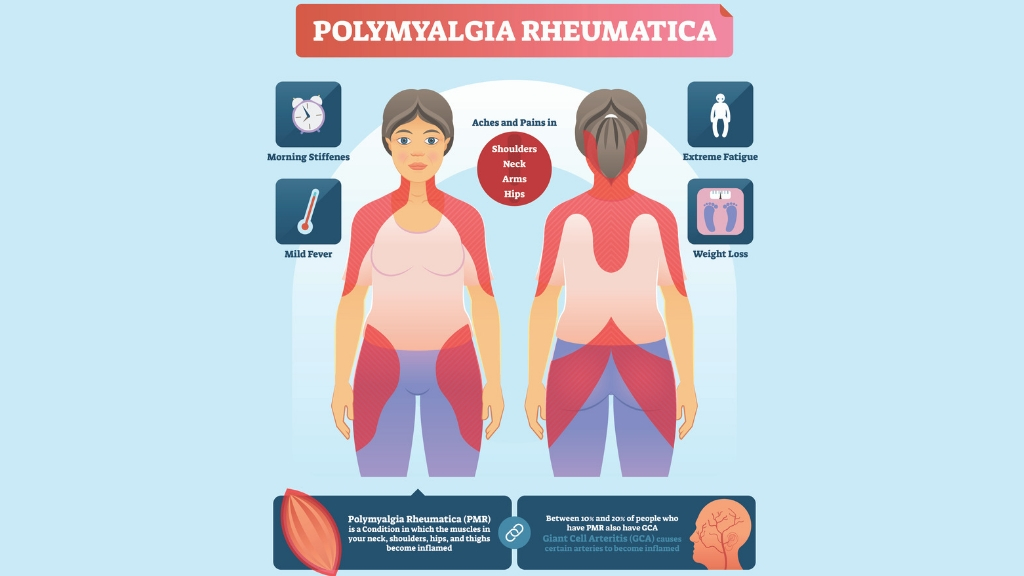How Polymyalgia and Fibromyalgia Differ + Pain Relief Tips for Both
6 minute read
Pain is pain, but sometimes it can be widespread and not clearly linked to a specific condition or injury. When there is no obvious cause, it can be difficult to assess. Widespread pain, fatigue, and stiffness can be a sign of one of two conditions—fibromyalgia or polymyalgia.
Both fibromyalgia and polymyalgia are pain-related conditions with similar symptoms. Understanding the differences will help with diagnosis and the development of an effective treatment plan because the quicker the better.
Fibromyalgia and Polymyalgia
Fibromyalgia is the more commonly known condition and causes muscle pain in the shoulders, upper arms, and hips and other “tender points.”
The pain is widespread and often severe, interfering with daily activities and quality of life. It is also commonly felt along with fatigue, insomnia, memory problems, and bowel or bladder problems.
Polymyalgia Rheumatica (PMR) causes muscle pain in similar areas of the body but is not as severe. This condition is more commonly felt after you have been immobile for a lengthy period of time or have been resting.
Polymyalgia is almost always more painful when you wake in the morning as compared to fibromyalgia, which hurts all day long.

The environment plays a role in the development of polymyalgia, and certain seasons may see more cases than others. Cold weather and flu viruses are associated with increased polymyalgia incidence and often symptoms can come and go with the weather.
Fibromyalgia, on the other hand, is associated with stress, trauma, and autoimmune conditions, so it is not as fleeting as its counterpart.
The one common factor between fibromyalgia and polymyalgia is inflammation. Inflammation is linked to a host of diseases and is the underlying cause for the pain of these two conditions.
Inflammation may be a necessary part of our immune defense system, but it can get out of control—this is when the damage occurs.
The Common Denominator
Because each condition affects everyone differently, and symptoms vary between the two, you can successfully treat both by attacking the cause and not the symptoms. The good news is that there are numerous ways you can successfully control inflammation and prevent the associated aches and pains.

Anti-Inflammatory Diet
There are certain foods that trigger inflammation and others that reduce it, so pain reduction depends on monitoring what you eat closely. The top foods to avoid include processed meats, fried foods, high-fat foods, sugar-laden foods, gluten, spicy foods, caffeine, and alcohol.
| Related: 15 Best Anti-Inflammatory Foods and Diet Tips |
To help improve inflammation you should be sure to include more fresh fruits and vegetables, ginger, green tea, lean meats, fresh fish or fish oil, and whole grains.
Turmeric
More commonly known for its ability to spice up your meals, turmeric has also been used in traditional medicine for centuries. Curcumin is the main compound in turmeric and it is both an antioxidant and anti-inflammatory agent.
| Related: Turmeric: The Natural Anti-Inflammatory |
By reducing inflammation in the body, joint and muscular pain associated with fibromyalgia and polymyalgia can be reduced. It can be found in some supplements specially designed for joint discomfort relief.

Probiotic Supplements & Foods
Inflammation can be made worse by an unhealthy gut, which is why probiotic support is important. Probiotics help to relieve inflammation by promoting healthy digestion.
Because 90 percent of your immune system lives within your gut (and this controls the inflammatory response), a healthy gut will encourage minimal inflammation.
Quit the Bad Habits
Both excessive alcohol consumption and smoking contribute to increased inflammation, which can make your pains worse. Smoking triggers an immune system response because of the foreign pathogens in your lungs. The response is primarily inflammatory, which will exacerbate your fibromyalgia or polymyalgia symptoms.
Alcohol interferes with your blood sugar levels, also triggering an inflammatory response. By cutting down or quitting both, you can live more comfortably.
Exercise
It may seem painful at first to exercise with fibromyalgia and polymyalgia. But when you keep moving, you protect your body in a number of ways. Exercise reduces inflammation that causes pain and also helps to promote weight loss. To help mitigate pain while exercising, stick to low-impact ones, like walking, swimming, etc.

Obesity exacerbates the pain associated with these conditions, so keeping trim will keep you pain-free. Exercise also improves your cardiovascular health and metabolism, which promotes optimal health overall, allowing your body a better chance of coping with and minimizing pain.
The Bottom Line
Both fibromyalgia and polymyalgia can interfere with your life. Early identification of the symptoms is your best bet to effectively treating your pain so your life doesn’t have to stop.
There may be slight differences in the conditions, but the underlying cause is the same. By curbing inflammation, you can successfully reduce the pain caused by both conditions.












